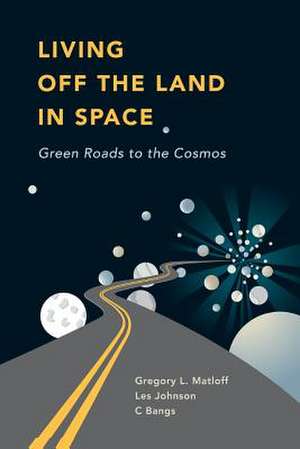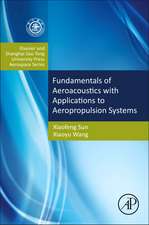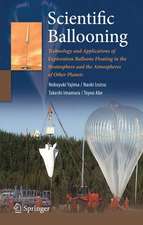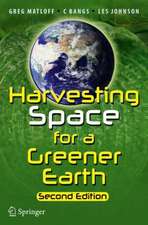Living Off the Land in Space: Green Roads to the Cosmos
Autor C Bangs, Greg Matloff, Les Johnsonen Limba Engleză Paperback – 17 sep 2014
| Toate formatele și edițiile | Preț | Express |
|---|---|---|
| Paperback (1) | 148.00 lei 3-5 săpt. | |
| Springer – 17 sep 2014 | 148.00 lei 3-5 săpt. | |
| Hardback (1) | 220.13 lei 3-5 săpt. | |
| Springer – 5 iun 2007 | 220.13 lei 3-5 săpt. |
Preț: 148.00 lei
Nou
Puncte Express: 222
Preț estimativ în valută:
28.32€ • 30.75$ • 23.79£
28.32€ • 30.75$ • 23.79£
Carte disponibilă
Livrare economică 01-15 aprilie
Preluare comenzi: 021 569.72.76
Specificații
ISBN-13: 9781489988775
ISBN-10: 1489988777
Pagini: 272
Ilustrații: XIV, 247 p.
Dimensiuni: 155 x 235 x 14 mm
Greutate: 0.39 kg
Ediția:2007
Editura: Springer
Colecția Copernicus
Locul publicării:New York, NY, United States
ISBN-10: 1489988777
Pagini: 272
Ilustrații: XIV, 247 p.
Dimensiuni: 155 x 235 x 14 mm
Greutate: 0.39 kg
Ediția:2007
Editura: Springer
Colecția Copernicus
Locul publicării:New York, NY, United States
Public țintă
Popular/generalDescriere
Human civilization has evolved to the point at which we can consider tapping space resources and expanding beyond Earth’s atmosphere. The Introduction surveys possible motivations for large-scale human emigration to space. Since our early ancestors began to move out of Africa, humans have constantly expanded their range. Today, the pattern of human settlement extends from pole to pole. Humans regularly visit the upper troposphere and ocean floor and technology has enabled a few to even reside above the atmosphere in space stations.
For the next few millennia at least (barring breakthroughs), the human frontier will include the solar system and the nearest stars. Will it better to settle the Moon, Mars, or a nearby asteroid and what environments can we expect to find in the vicinity of nearby stars are questions that need to be answered if mankind is to migrate into space.
For the next few millennia at least (barring breakthroughs), the human frontier will include the solar system and the nearest stars. Will it better to settle the Moon, Mars, or a nearby asteroid and what environments can we expect to find in the vicinity of nearby stars are questions that need to be answered if mankind is to migrate into space.
Cuprins
The Old Frontier.- The New Frontier.- The Rocket and Its Limits.- The First “Green” Space Technologies.- Probes to the Planets:Where We've Been on Our Journey.- Probes to the Stars:Concept Studies.- Breaking Out into Space:Visionary Futures.- Thinking Interstellar.- Technological Readiness.- Space Brakes(“Living of the Land” by Using a Planetary Atmosphere).- The Ion Trial.- The Orbital Steam Locomotive.- Sky Clippers.- Art or Science?.- Space Beanstalks.- Chemical Propulsion for Space Exploration: Good for Yesterday,Today and Tomorrow.- Human Exploration.- Defending the Earth.- Space Miners.- Some Exotic Possibilities.- Sights on Centauras.
Recenzii
From the reviews:
"The goal of the book is to provide a realistic view of what might be possible with technologies that are accessible in the near future. A wealth of references at the end of each chapter point the way to further resources. Living Off the Land in Space should satisfy anyone who wants to learn about space colonization and the propulsion methods that will make it happen." (Bernd Henschenmacher, www.centauri-dreams.org, September, 2007)
"This book is … about ways of powering spaceships to get to other worlds. … the book explores ways of accelerating spaceships using the environments encountered on the journey through space. … The book discusses other means of powering spacecraft, including gravity assists from planetary flybys, ion drives, solar sailing and electromagnetic tethers. … Overall the book is more a review of current or developing techniques … . I found it an enjoyable read and informative." (P L Dyson, Australian Physics, Vol. 45 (1), 2008)
"A sustainable long-term presence in space certainly requires the use of in-space resources with new technologies. This is the subject of the book Living off the Land in Space. Green Roads to the Cosmos. The word Green refers to the use of technologies lessening or eliminating any dependence on Earth, not because they have no impact on Earth’s environment. … I can recommend this book to everyone interested in the future of space exploration. The book is written by a pair of scientists … ." (Claude Semay, Physicalia, Vol. 30 (2), 2008)
"The goal of the book is to provide a realistic view of what might be possible with technologies that are accessible in the near future. A wealth of references at the end of each chapter point the way to further resources. Living Off the Land in Space should satisfy anyone who wants to learn about space colonization and the propulsion methods that will make it happen." (Bernd Henschenmacher, www.centauri-dreams.org, September, 2007)
"This book is … about ways of powering spaceships to get to other worlds. … the book explores ways of accelerating spaceships using the environments encountered on the journey through space. … The book discusses other means of powering spacecraft, including gravity assists from planetary flybys, ion drives, solar sailing and electromagnetic tethers. … Overall the book is more a review of current or developing techniques … . I found it an enjoyable read and informative." (P L Dyson, Australian Physics, Vol. 45 (1), 2008)
"A sustainable long-term presence in space certainly requires the use of in-space resources with new technologies. This is the subject of the book Living off the Land in Space. Green Roads to the Cosmos. The word Green refers to the use of technologies lessening or eliminating any dependence on Earth, not because they have no impact on Earth’s environment. … I can recommend this book to everyone interested in the future of space exploration. The book is written by a pair of scientists … ." (Claude Semay, Physicalia, Vol. 30 (2), 2008)
Notă biografică
At present, Dr Matloff teaches physics and astronomy as an Assistant Professor at New York City Technical College, CUNY. He has pioneered the application of gossamer spacecraft to deep-space exploration and has served as a Faculty Fellow in summer 1999, 2000 and 2001 at NASA Marshall Spaceflight Center (MSFC), Huntsville AL. He has participated there on a design team planning interstellar missions propelled by solar sails unfurled Sunward of the Earth. He consults for NASA through Gray Research and Teledyne Brown, in Huntsville AL.
Les Johnson manages the Science Programs and Projects Office at NASA's Marshall Space Flight Center. In addition to his NASA credentials, Johnson also is an inventor. He holds three patents, including one received in 1989 for a laser-triggered, fiber-optic neutron detector. His most recent patent was awarded in July 2003 for an electrodynamic sail for propulsion. Johnson is also a two-time recipient of the NASA Exceptional Achievement Medal.
Ms Bangs’ work is in many permanent collections, including MSFC, the US Library of Congress, the Mint Museum and the Chrysler Museum.
Les Johnson manages the Science Programs and Projects Office at NASA's Marshall Space Flight Center. In addition to his NASA credentials, Johnson also is an inventor. He holds three patents, including one received in 1989 for a laser-triggered, fiber-optic neutron detector. His most recent patent was awarded in July 2003 for an electrodynamic sail for propulsion. Johnson is also a two-time recipient of the NASA Exceptional Achievement Medal.
Ms Bangs’ work is in many permanent collections, including MSFC, the US Library of Congress, the Mint Museum and the Chrysler Museum.
Textul de pe ultima copertă
A number of new space-propulsion technologies- including the solar sail, the solar-electric rocket, solar-thermal propulsion, aerocapture, tethers and advanced chemical propulsion- are becoming operational or are in an advanced state of development. This book draws parallels with the settlement of terrestrial frontiers to investigate how new space propulsion techniques may help future space settlers exploit extraterrestrial resources to establish independence from the Earth.
"Living Off the Land in Space," a collaboration among two space scientists and an artist, is illuminated with many NASA-derived computer-generated images, including drawings, and presents the human (as well as the technological) side of space settlement. It will be an inspiring and indispensible source for those wishing to share in this great adventure.
"Living Off the Land in Space," a collaboration among two space scientists and an artist, is illuminated with many NASA-derived computer-generated images, including drawings, and presents the human (as well as the technological) side of space settlement. It will be an inspiring and indispensible source for those wishing to share in this great adventure.
Caracteristici
Presents a visionary concept for future development of space travel
Describes the enabling technology for future propulsion concepts
Demonstrates how mankind will ‘live off the land in space’ in migration from Earth
Considers the Moon, Mars and asteroids as future colonies and bases
Shows how concepts like space clippers, space tethers and Earth defence can be developed
Includes supplementary material: sn.pub/extras
Describes the enabling technology for future propulsion concepts
Demonstrates how mankind will ‘live off the land in space’ in migration from Earth
Considers the Moon, Mars and asteroids as future colonies and bases
Shows how concepts like space clippers, space tethers and Earth defence can be developed
Includes supplementary material: sn.pub/extras






















